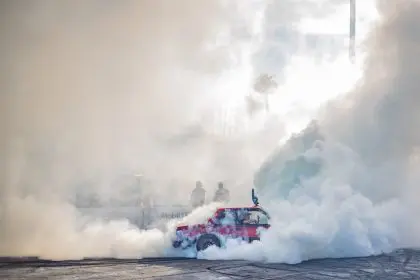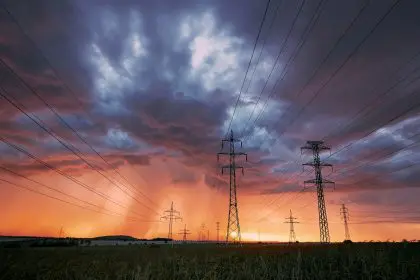Health officials issued a comprehensive air quality warning affecting millions of residents across the New York metropolitan region as dangerous smoke conditions descended upon the area. The alert encompasses not only New York City but extends to seven surrounding counties, creating widespread concern about respiratory health and outdoor activities throughout the affected zones.
The warning period spans a critical 12-hour window from 11 a.m. to 11 p.m. on Wednesday, during which air quality conditions are expected to reach levels that pose health risks to vulnerable populations. Officials emphasized that residents should take appropriate precautions to protect themselves from the deteriorating atmospheric conditions.
Environmental monitoring systems indicate that the Air Quality Index will climb to approximately 105 during peak hours, placing conditions firmly in the unhealthy category for sensitive groups. This measurement represents a significant departure from normal conditions and warrants serious attention from residents across the affected region.
Eight counties face hazardous conditions
The comprehensive alert affects New York City along with seven additional counties throughout the Hudson Valley and surrounding regions. Dutchess, Orange, Putnam, Rockland, Sullivan, Ulster and Westchester counties all fall under the official warning, creating a substantial geographic area where residents must exercise increased caution.
Notably, Long Island and the Jersey Shore areas are expected to escape the worst effects of the current air quality crisis. Meteorological patterns and wind directions have spared these coastal regions from the most severe impacts, though conditions could change as weather systems evolve throughout the day.
The selective nature of the alert demonstrates how localized weather patterns can dramatically affect air quality distribution. Geographic features and prevailing winds play crucial roles in determining which areas experience the most severe impacts from distant pollution sources.
Canadian wildfires drive regional crisis
Hundreds of active wildfires burning across Canada’s prairie provinces serve as the primary source of the hazardous air quality conditions affecting the tri-state region. Smoke from these distant blazes travels hundreds of miles through atmospheric currents before settling over populated areas in the northeastern United States.
The phenomenon represents a recurring pattern that has become increasingly common in recent years as wildfire activity intensifies across North America. Smoke particles can remain suspended in the atmosphere for extended periods, allowing them to travel vast distances before creating health hazards in regions far from the original fire sources.
Current atmospheric conditions favor the transport of smoke particles from the Canadian prairie regions directly into the New York metropolitan area. Prevailing wind patterns and atmospheric stability contribute to the concentration of particulate matter over densely populated areas where millions of people face potential health risks.
Historical context reveals escalating risks
The current air quality crisis recalls the severe conditions experienced in June 2023, when smoke from Quebec wildfires created unprecedented hazardous conditions throughout New York City. During that event, the Air Quality Index reached an extraordinary 484, representing not only the highest reading ever recorded in the city but also the worst air quality anywhere in the world on that particular date.
That historic event demonstrated the potential for wildfire smoke to create catastrophic air quality conditions even in areas hundreds of miles from active blazes. The 2023 incident served as a wake-up call for emergency management officials and health authorities about the growing threat posed by distant wildfire activity.
Atmospheric scientists note that such extreme events may become more frequent as climate change continues to influence wildfire patterns across North America. The increasing intensity and duration of wildfire seasons create more opportunities for smoke transport to affect distant urban areas.
Air quality index system explained
The Air Quality Index provides a standardized method for communicating air pollution levels and associated health risks to the public. The system employs six distinct categories, each represented by specific colors and numerical ranges that help residents understand current conditions and appropriate responses.
Good conditions fall within the 0 to 50 range and are represented by green indicators. Moderate conditions span 51 to 100 and use yellow coding. The unhealthy for sensitive groups category covers 101 to 150 with orange indicators, while unhealthy conditions range from 151 to 200 with red coding.
Very unhealthy conditions spanning 201 to 300 use purple indicators, while hazardous conditions above 301 employ maroon coding. The current alert threshold of 105 places conditions in the orange category, indicating particular risks for vulnerable populations including children, pregnant women, older adults, and individuals with heart or lung diseases.
Atmospheric science behind red sun phenomenon
The presence of wildfire smoke in the atmosphere creates distinctive visual effects that many residents may observe during the current air quality event. Smoke particles can cause the sun and moon to appear with unusual reddish or orange glows, creating dramatic but concerning visual indicators of poor air quality.
This coloration phenomenon results from the interaction between sunlight and increased particulate matter in the atmosphere. Blue light waves have shorter wavelengths while red light waves have longer wavelengths, creating different behaviors when encountering smoke particles suspended in the air.
When smoke increases the amount and size of particulate matter in the atmosphere, these particles preferentially absorb shorter blue wavelengths while allowing longer red wavelengths to pass through. This selective filtering process results in the distinctive reddish appearance that serves as a visual indicator of compromised air quality conditions.
Summer air quality challenges compound risks
New York City regularly faces air quality challenges during summer months, particularly during heat wave conditions that create additional atmospheric complications. Higher temperatures and increased humidity levels contribute to stagnant air conditions that trap pollutants from vehicles and industrial sources.
These local pollution sources combine with temperature and sunlight to create chemical reactions that produce fine particulate matter. The combination of local pollution and distant wildfire smoke creates compounded health risks that exceed those posed by either source individually.
Urban heat islands and reduced air circulation during summer months exacerbate the retention of pollutants in metropolitan areas. The current wildfire smoke event occurs against this backdrop of existing seasonal air quality challenges, creating particularly concerning conditions for respiratory health.
Weather forecast intensifies concerns
Meteorological conditions throughout the remainder of the week are expected to maintain and potentially worsen current air quality problems. Temperatures will continue rising throughout Wednesday, reaching the mid to upper 80s during afternoon hours while humidity levels increase simultaneously.
Thursday forecasts predict the hottest conditions of the year so far, with temperatures climbing into the upper 80s and low 90s across most of the region. Coastal areas may experience some relief with temperatures remaining in the 70s, but inland areas will face the most challenging combination of heat and poor air quality.
The persistence of smoke and haze through the extended forecast period means that residents should prepare for multiple days of compromised air quality conditions. Friday and Saturday forecasts include possibilities of thunderstorms that could help clear the atmosphere, but also introduce additional weather-related complications for outdoor activities and air quality management.

















